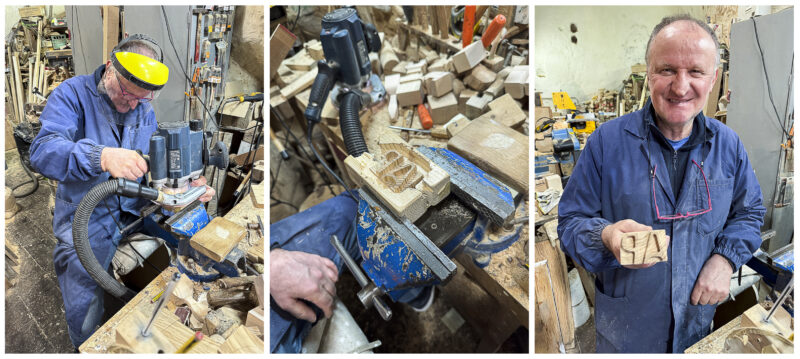Matera: from faded glory to living heritage – a journey through the Sassi and their stories
Discover Matera, a UNESCO World Heritage Site and one of the oldest cities in the world. From the abandoned Sassi to their revival as a cultural gem – a journey through stone, history and spirituality in the heart of southern Italy
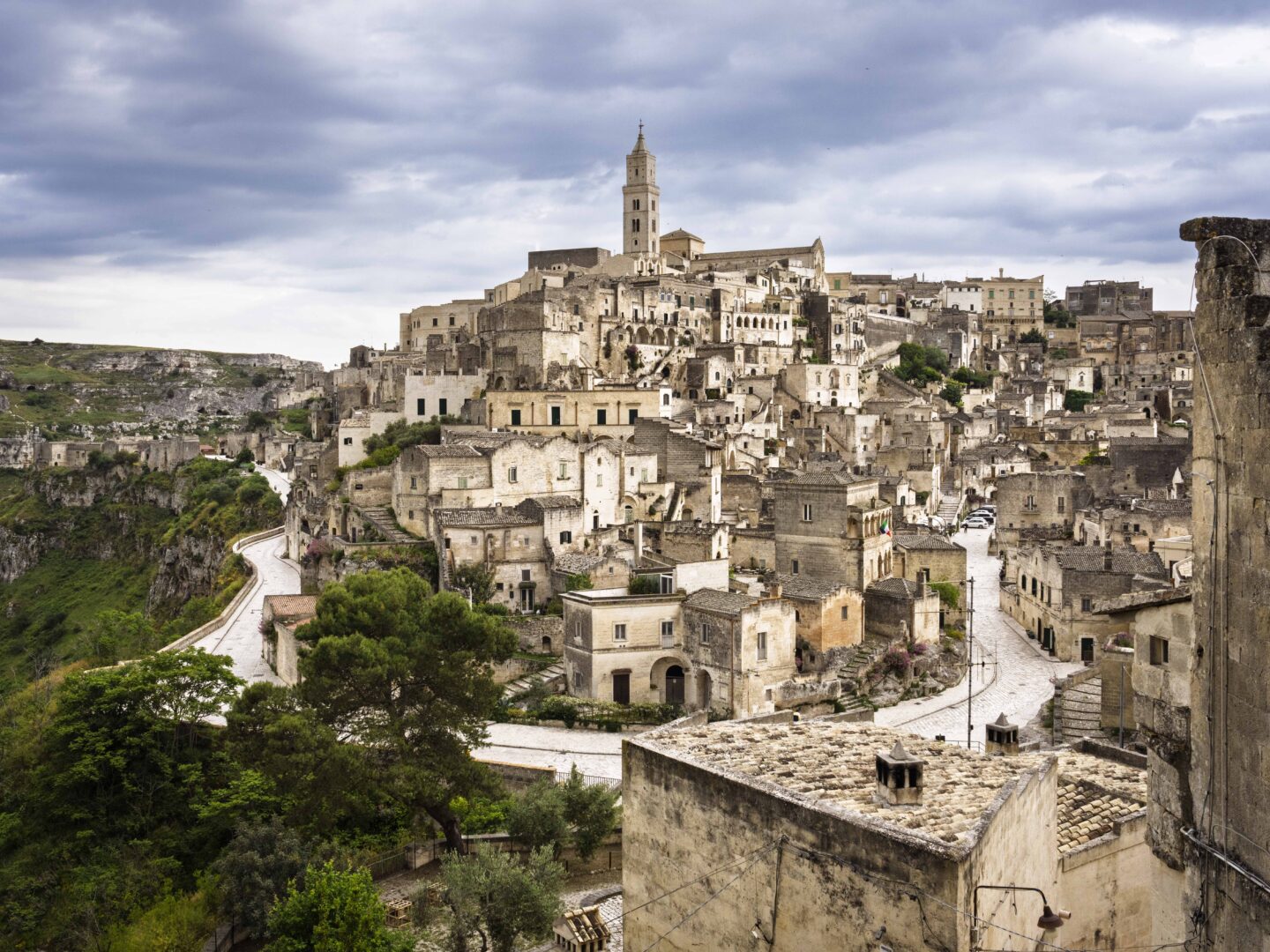
The Sassi of Matera: my first steps in a city carved from stone
I walk from the streets of modern Matera to the Sassi and wonder if what I will see will match the images in my head and the photos in magazines. Then I get to the main Piazza Vittorio Veneto. In front of me is the Sasso Barisano, carved deep into the landscape. The view is breathtaking. I was expecting one thing – but this is actually so much better. A maze of alleys, steps, small houses and rocks unfolds before my eyes. Will I find my way here?
Along the Via del Corso, I’m really taken with the interesting-looking Chiesa del Purgatorio. Inside, a lady from the Oltre L'Arte association welcomes me. She pulls out a map of the Sassi, points out the must-dos and works out a complete tour for me. Armed with her tips, I take my first steps down the stairs. The stones are calling. I surrender to the Sassi and discover a world that is both ancient and surprisingly lively.
In this blog, I'll take you on a journey through time and show you what life was like for the people of Matera, a city like no other.
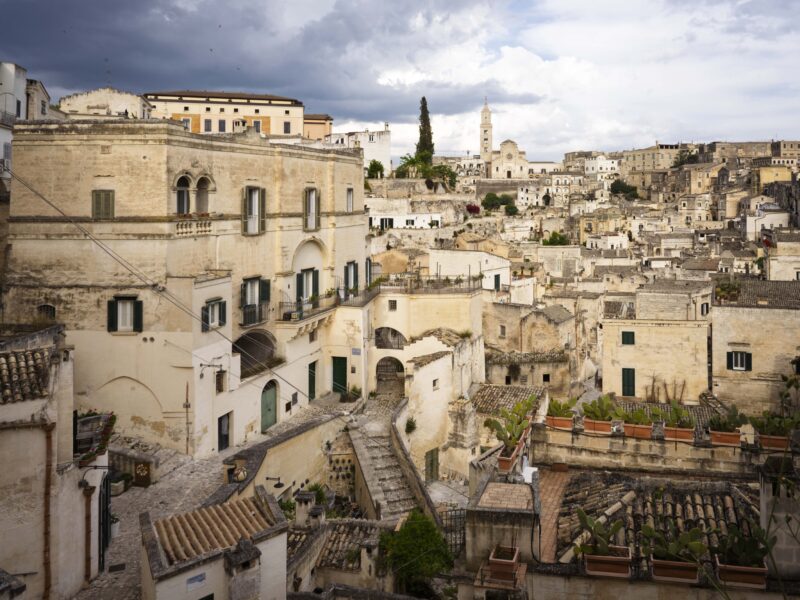
La Vergogna d'Italia: the forgotten past of Matera
Matera is one of the oldest cities in the world, with its origins dating back to the Neolithic period. But it wasn't until the 12th century that different ethnic groups – Albanians, Croats, Jews and Lombards – started to settle in the carved cave dwellings of the Sassi. This place has a unique folk culture, with its own dialect, traditions and way of life that have lasted for centuries.
People in the Sassi were living in terrible conditions right up until the 20th century. The cave dwellings, carved out of soft tuff, offered little protection against the cold, damp or disease. Humans and animals shared the same space: donkeys, pigs and chickens literally lived alongside the family. There was no running water, electricity, heating or sewage systems. The hygiene situation was terrible, and diseases like malaria and tuberculosis were rife. Infant mortality was really high – in some years, almost half of all newborns died.
There was basically no medical care at all. Instead, people relied on folk beliefs and the help of a local curandera – a female healer who tried to ward off disease with herbs, rituals and incantations. Poverty was everywhere. Families often ate from the same bowl, and not many people could read or write.
Back in 1948, the Italian Communist Party leader Palmiro Togliatti came to Matera and called the city 'La Vergogna Nazionale', which translates as 'the national disgrace'. Two years later, Prime Minister Alcide De Gasperi did the same, having been deeply shocked by what he found. Back in 1952, the Legge Speciale per lo Sfollamento dei Sassi was passed, which basically meant that people had to leave the old town and move to the new, flat part of the city.
About 17,000 people were relocated. The Sassi were abandoned and fell into disrepair. It wasn't until the 1980s that things started to change, and it was a slow process of revaluation and restoration. Nowadays, the Sassi are a living heritage, with boutique hotels, museums and restaurants – but you can still feel the past in every stone.
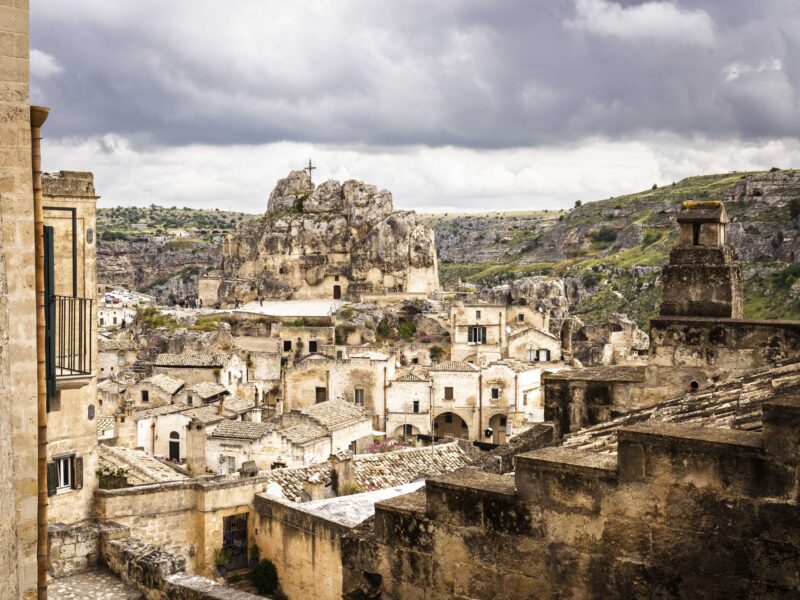
The two Sassi of Matera – Barisano and Caveoso
The Sassi of Matera are two historic districts – Sasso Barisano and Sasso Caveoso – which were literally carved out of the rocks of La Murgia. Between these two lies a higher plateau with the districts of Civita and Castelvecchio, which together form the beating heart of ancient Matera.
You know what makes this city so special? It's the negative architecture. Instead of building, people dug into the soft tuff stone to create living spaces. They later added brick facades, stairs and terraces, creating a layered city that stretches like a labyrinth across the hills.
Sasso Barisano, the most accessible part of the old town, has been largely restored and today is home to charming B&Bs, artisan shops and restaurants. You can walk down cobbled streets where the past and present mix.
Sasso Caveoso, on the other side of Piazza Vittorio Veneto, is more rough and has more of an authentic feel. The cave dwellings here are more simple, and the atmosphere is quieter. It's a place where you can feel Matera as it once was – a city of stone, silence and hard times.
The two Sassi tell the story of a community that's adapted to its environment for centuries and is now coming back to life – not as a disgrace, but as heritage.

UNESCO heritage: the hidden water system of Matera
Back in 1991, they found a complex network of canals, reservoirs and cisterns under the Sassi alleys. These collected rainwater and spring water and distributed it to the cave dwellings. The clever underground water system, dug out by hand into the rocks, made life in Matera possible for centuries.
The system worked really efficiently. Water flowing from roofs and streets was collected and channeled with spring water through narrow channels to deep underground cisterns. The biggest of these, the Palombaro Lungo under Piazza Vittorio Veneto, is more than 15 metres deep and carved entirely out of the rock. There's another one, the Palombaro del Sasso Caveoso, on the other side of the city. The two reservoirs had a huge impact on daily life in the Sassi. Suddenly, there was access to drinking water – it wasn't purified, but it was life-saving.
The name palombaro comes from palomba, which is a retaining wall that held back the water in the courtyard of a house. Back in 1846, Monsignor Di Macco came up with a top-notch cistern for the folks living in Sasso Caveoso. It was lined with a layer of impermeable clay and had openings in the ceiling through which rainwater could seep in. There was a simple well in the courtyard above, with a bucket you could use to get water. There was even an overflow system that sent excess water to the open sewers, which helped to keep the city clean.
It's mostly down to this clever hydraulic system that Matera made the UNESCO World Heritage List in 1993. It's not just about the architecture, but also how people and nature have coexisted here for centuries.
The rock churches of Matera: spirituality in stone
One of the coolest things about Matera is its chiese rupestri – rock churches carved into the tuff stone of the Sassi. These small, often hidden places of worship are really common in Sasso Caveoso, where you can still see frescoes that are hundreds of years old. These churches were first built in the 8th century by monks who turned natural caves into spiritual places. They were used until the 1950s, when the population was moved to the Piano.
Here are some of the most beautiful rock churches that you should not miss:
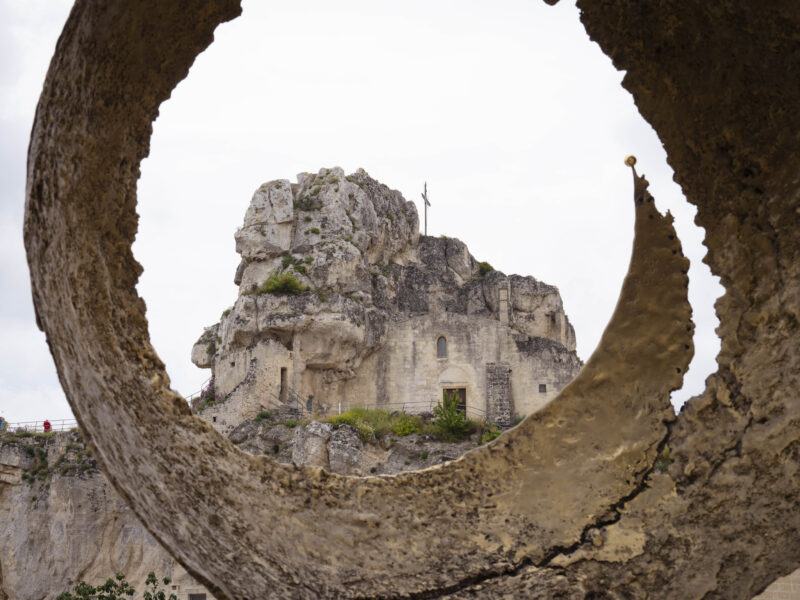
San Pietro Barisano
This is the biggest rock church in Matera, and it was built between the 12th and 13th centuries. A video installation brings the past to life with the presumed voice of Don Giovanni Ambrosecchia, a 17th-century priest. You'll hear sacred chants, see the stolen painting of the coronation (1601) come to life, and discover Pietro Simone's organ from 1706.
A special part of the church is the sepolcreto, where young priests were buried in niches. It wasn't until they'd completely rotted away that their bones were collected and made into relics – a ritual that symbolised the transition from the physical to the spiritual world.

Madonna delle Virtu Vecchia – San Nicola dei Greci
This 12th-century church was built in the Romanesque style and has three naves. There's a passageway that leads to a second rock church above it: San Nicola dei Greci, a 10th-century building that was later used as a cemetery. The walls are covered in Byzantine frescoes, and there are two tombs on the floor that tell the story of its history.

Santa Lucia alle Malve
This 9th-century church is attached to a Benedictine nunnery. The main part of the church is still consecrated, but the side aisles were converted into living spaces and stables, which were used until 1960. Inside, you'll find frescoes from the 11th to 17th centuries that have great historical value.
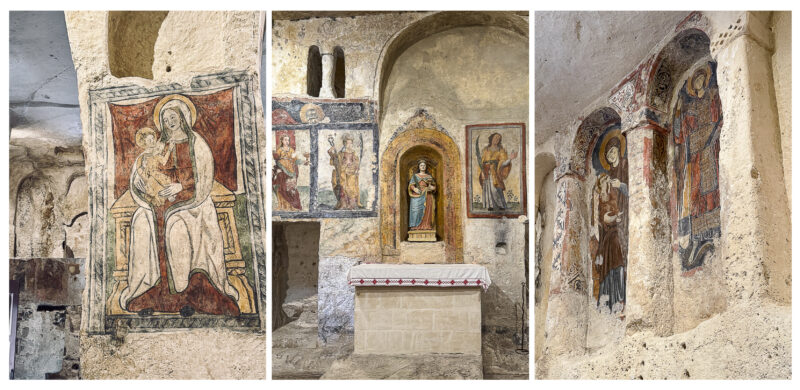
Santa Maria de Idris and San Giovanni in Monterrone
Located on a protruding rock with panoramic views. Santa Maria de Idris has been mentioned since the 14th century and has frescoes from the 17th and 18th centuries. There's a passageway that leads to San Giovanni in Monterrone, which has some impressive 11th-century architecture and frescoes.
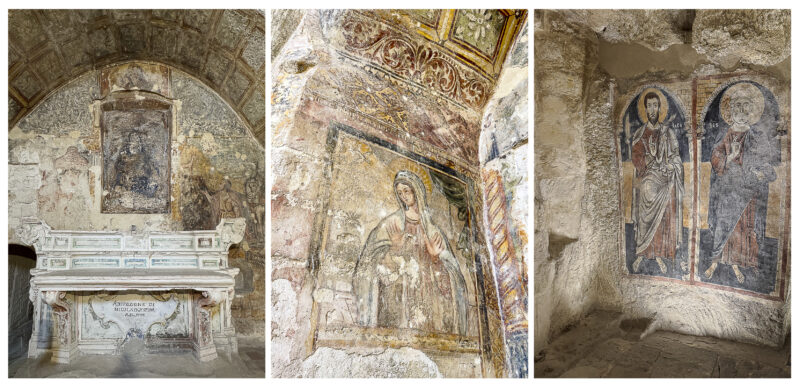
Santa Maria de Armenis
This 11th-century church was part of a Benedictine abbey that was run by Armenian monks. As well as the religious side of things, there are ancient cave dwellings to explore. Here, there are papier-mâché statues used during the annual celebration of Santa Maria della Bruna, the patron saint of Matera.
The story of Santa Maria della Bruna
According to an ancient legend, a mysterious young woman appeared to a farmer returning to the Sassi. She asked for a lift on his cart, and when they got to the city gate, she turned into a statue of the Virgin. She whispered, "This is how I want to enter the city every year, on a decorated cart."
Since then, Matera has celebrated its patron saint on 2 July with a mixture of the sacred and the secular. The day begins early with a shepherds' procession and fireworks. Later on, the Madonna statue is carried through the city in a grand procession, with more than 90 knights in historical costume.
The highlight is the papier-mâché float, pulled by mules. After a tour of the city, the float is literally torn apart by the crowd in Piazza Vittorio Veneto – a ritual of rebirth and renewal. Everyone takes home a piece of the float as a lucky charm. The celebrations end with a fireworks display over the Gravina and the Sassi, followed by the traditional wish: 'A mmogghjë a mmogghjë a quonn cj vahnë' – 'Next year even better'.

Cultural gems in the Sassi
Matera is so much more than just rock churches and panoramic views. If you wander through the alleys of the Sassi, you'll discover a wealth of culture, art and history – all hidden in cave dwellings, palaces and museums that bear witness to a city that is constantly reinventing itself.
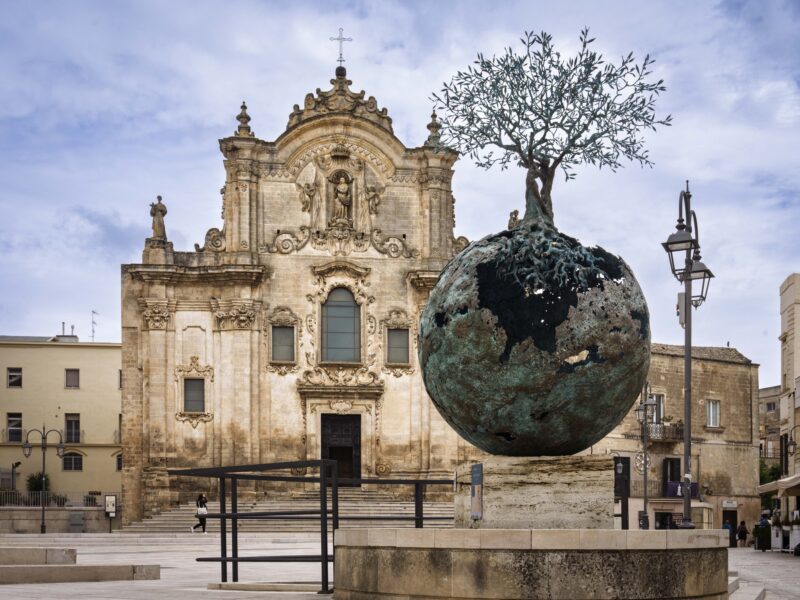
Antica Casa Grotta – life as it was
In the Sassi, you will find several case grotte – cave dwellings that are fully furnished as they once were. In the Antica Casa Grotta in Via Fiorentini, you can see how humans and animals lived together in one space, without much comfort, but with a srong connection to their surroundings. It gives you a real feel for the hard, simple life of the past.
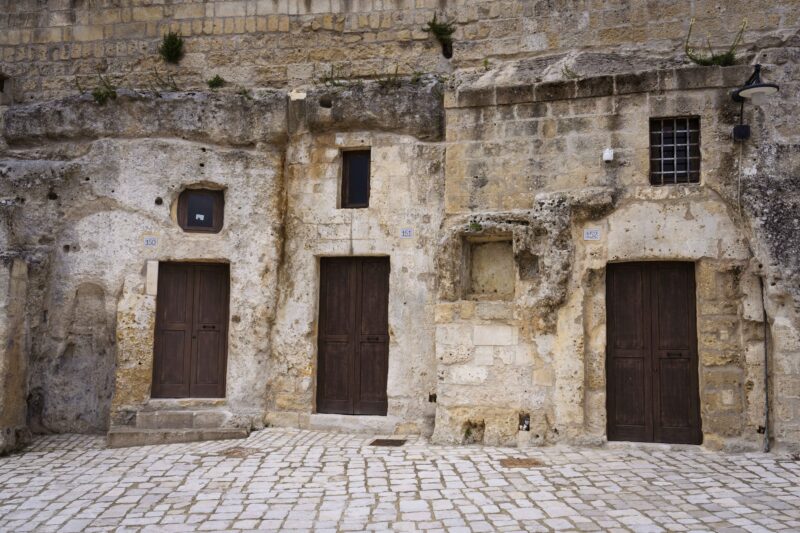
Casa di Ortega – art in exile
This fortified house is a hidden gem. It exhibits the works of Spanish artist José Ortega, who lived in Italy during the Franco dictatorship. His art, made with a unique papier-mâché technique, is powerful and three-dimensional – a visual story of the repression in his home country. The house itself is amazing, with a balcony overlooking the Sasso Barisano and a terrace looking out over the gorge and caves.

MUSMA (Museum of Contemporary Sculpture)
The MUSMA (Museo della Scultura Contemporanea) is housed in the impressive Palazzo Pomarici, also known as the 'Palace of a Hundred Rooms'. This building, which is partly carved into the rocks, used to be a Dominican monastery and later the home of the Pomarici family. The hypogea – underground rooms – were used as stables, wine cellars and oil mills.
Today, MUSMA is the most important Italian museum dedicated to sculpture. The collection includes more than 400 works by Italian and international artists, from the late 19th century to the present day. You’ll find sculptures in bronze, marble, ceramics, papier-mâché, tuff and wood, as well as drawings, medals and art books.
What makes the museum special is the way it mixes art and space. The sculptures are exhibited in caves, cisterns and old workshops, which makes the emptiness and fullness of the artworks coincide perfectly with the architecture of the Sassi.

The Cathedral of Matera – a Romanesque gem in tuff stone
Perched high on the Civita plateau, overlooking the city, is the Cattedrale della Madonna della Bruna e di Sant'Eustachio. Built from tuff stone in the 13th century, this cathedral is a rustic yet majestic sight, visible from afar.
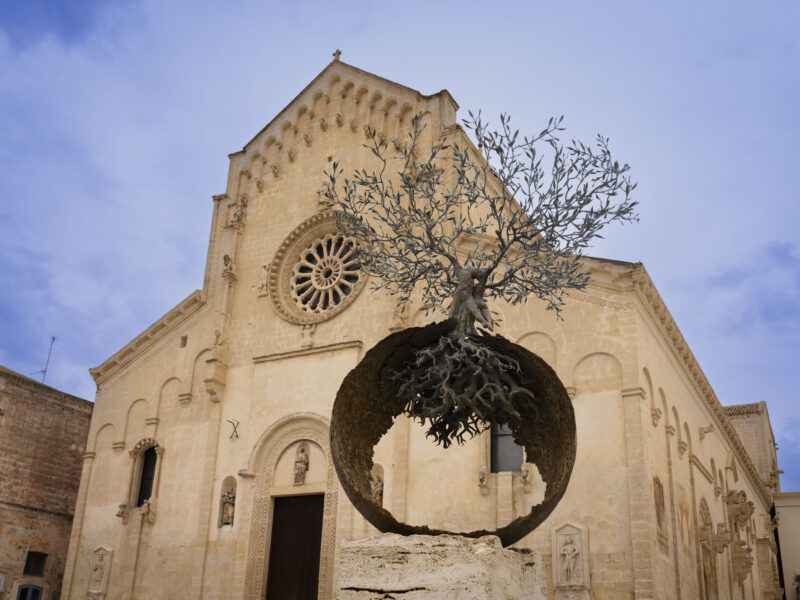
The cathedral has undergone several renovations over the centuries and was reopened in 2016 after a thorough 13-year restoration. Inside, you can admire a rich interior with stucco work, frescoes and sculptures, including a beautiful altar and a centuries-old stone nativity scene by Altobello Persio. During the restoration, hidden frescoes were uncovered, including a fragment of the Last Judgement.

The Cuccù of Matera: a symbol with a story
Among the stones of Matera lives a small, colourful secret: the cuccù. This hand-made ceramic whistle shaped like a cheerful chicken was the ultimate toy for children in the Sassi in the 1950s. Anyone who had one held something special – a small status symbol with which you could say, 'Look, I have something you don't have.'
But the cuccù is more than just a children's toy. Originally, it was used as a protective amulet against evil spirits that could haunt houses. Later on, it took on a new meaning: happiness, serenity and fertility. That's how the tradition of giving a cuccù to a bride and groom on their wedding day came about – a colourful symbol of a happy marriage.
Today, you can find the cuccù in all shapes and sizes, often richly decorated with flowers, birds and geometric patterns. It looks great on its own, but it's also got a kind of magical vibe.
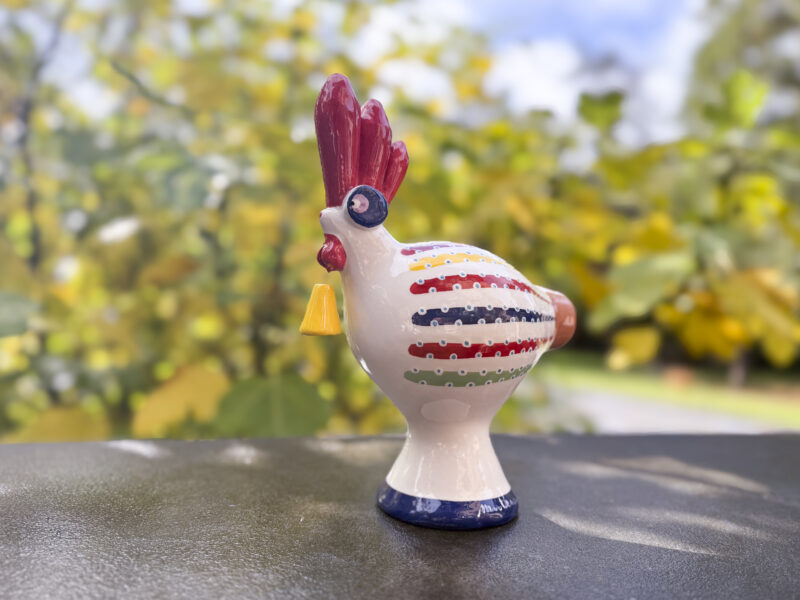
Where to find the most beautiful crafts of Matera
- Maria Bruna Festa – for refined ceramics
- Geppetto – specialising in authentic cuccùs
- Mancini – for handmade wooden bread stamps, a tribute to Matera's baking tradition
